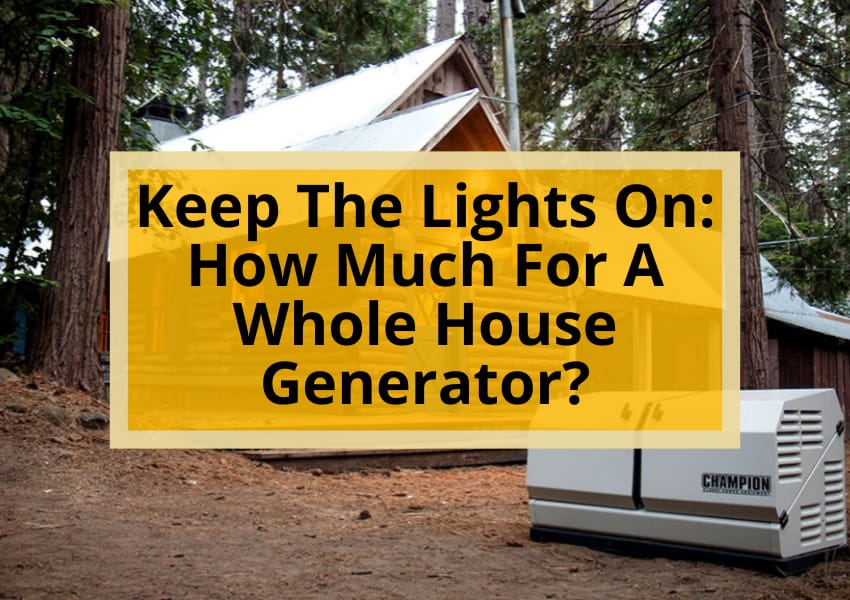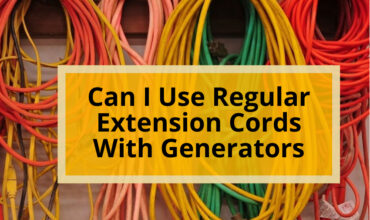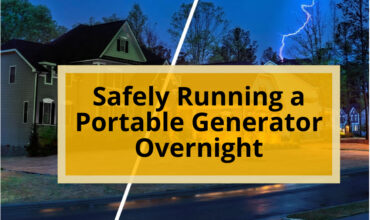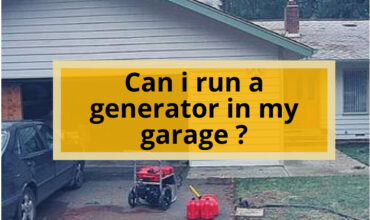In today’s world, power outages caused by extreme weather events have become a common occurrence. As a result, homeowners are increasingly seeking backup power sources for their homes to ensure uninterrupted access to electricity.
Whole-house generators are a popular solution for this problem, but they come with a high price tag. The cost of a whole-house generator varies depending on factors such as fuel source, output capacity, and installation costs.
This article will provide an overview of the different types of whole-house generators available and explore the costs associated with each, helping homeowners to determine which solution is right for them.
To begin with, there are several types of whole-house generators available, each with its own fuel source. Gas-fueled generators are a popular choice, given their affordability and availability. However, they require regular maintenance and can be noisy.
Standby generators, on the other hand, are more expensive but offer greater reliability and require less maintenance. Inverter generators are another option, which consume less gas and reduce noise and pollution.
Finally, solar-powered generators bring ongoing fuel costs down to zero, but they are expensive to install and require ample sunlight to function efficiently. Understanding the differences between these various types of whole-house generators is essential to making an informed decision about which one is right for your home.
Types and Fuel Sources
The cost of whole-house generators varies depending on the type and fuel source, with options ranging from fossil fuel-powered generators to clean and renewable solar power solutions.
Gas-fueled whole-house generators are the most common type of generator and can cost anywhere from $1,000 to over $20,000, with an average cost of around $5,000.
Standby generators are permanent installations integrated into your home’s electrical panel and natural gas line and can cost $10,000-$20,000 depending on capacity.
Inverter generators adjust engine intensity as needed, consume less gas, and reduce noise and pollution.
EcoFlow offers battery-powered whole-home backup power solutions that allow solar charging.
Portable gas generators are not practical for indoor use during a power outage and cannot be used as a whole-house backup solution.
Portable power stations incorporate lithium-ion or LiFePo$ batteries and can operate as solar generators with the addition of solar panels.
The installation process for whole-house generators can be complex, and it’s important to hire a professional to ensure the generator is installed safely and correctly.
Additional costs to consider include connectors, a transfer switch, permits, and professional installation.
Many states require permits for the installation of whole-house generators, with permit costs usually ranging between $50 and $200.
When considering the environmental impact of whole-house generators, it’s important to note that fossil fuel-powered generators produce emissions that contribute to air pollution and climate change.
On the other hand, solar power solutions do not require any fossil fuels to operate and bring ongoing fuel costs down to $0.
It’s essential to weigh the benefits and drawbacks of each type of generator and fuel source to determine which option is best for your needs and budget.

Cost Breakdown
Installation costs for a backup generator vary based on factors such as fuel source, output capacity, and location, with an average cost range of $500 to $3000, according to industry experts. However, this does not include the cost of the actual generator itself.
The upfront investment for a gas-fueled whole-house generator can range from $1,000 to over $20,000, with an average cost of around $5,000. This cost increases significantly for standby generators, which are permanent installations integrated into the home’s electrical panel and natural gas line and can cost $10,000-$20,000 depending on capacity.
Additional costs to consider include connectors, a transfer switch, permits, and professional installation. The transfer switch that connects a generator to the home wiring may cost anywhere from $150 to $1000, and an electrician is needed for installation.
Many states require permits for the installation of whole-house generators, with permit costs usually ranging between $50 and $200. Moreover, fuel source and refueling expenses significantly impact ongoing operating costs. Gas generators range in price from $3,000 to $20,000 depending on output capacity, while diesel generators require less maintenance and burn fuel more efficiently than gas models.
Propane is great for off-grid applications but tends to be more expensive than gasoline or natural gas, while natural gas generators connect to a utility gas line, allowing for unlimited use but can cause fuel costs to add up. Finally, solar generators do not require any fossil fuels to operate and bring ongoing fuel costs down to $0.
also read : Inverter Power: How Long Can Your Appliances Run?
Considerations and Ongoing Costs
Factors such as fuel type, output capacity, and maintenance requirements should be carefully considered when evaluating the ongoing costs of a backup power source.
Fuel efficiency is an important consideration, as it impacts the amount of fuel needed to power the generator and the associated costs.
Diesel generators are generally more fuel-efficient than gas models, and propane can be a good choice for off-grid applications. However, propane tends to be more expensive than gasoline or natural gas.
Natural gas generators connect to a utility gas line, allowing for unlimited use but can cause fuel costs to add up.
Solar generators do not require any fossil fuels to operate and bring ongoing fuel costs down to $0.
Maintenance costs should also be taken into account when evaluating the ongoing costs of a backup power source.
Regular maintenance is necessary to keep the generator in good working order and prevent breakdowns. Maintenance costs may include oil changes, filter replacements, and other routine maintenance tasks.
It is important to choose a generator with a reliable reputation and a good warranty, as repairs can be costly.
In addition, it may be beneficial to invest in a maintenance plan or service contract to ensure that the generator is properly maintained and serviced over time.
By considering fuel efficiency and maintenance costs, homeowners can choose a backup power source that provides reliable power during outages without breaking the bank.
Frequently Asked Questions
How long can a whole-house generator run for?
The duration of a whole-house generator’s operation depends on various factors such as generator maintenance, fuel consumption, and the generator’s output capacity. Regular maintenance and efficient fuel consumption can prolong the generator’s runtime.
Can a whole-house generator be used to power appliances with high energy needs, such as an electric stove or dryer?
A whole-house generator can power high-consumption appliances like electric stoves or dryers, but it depends on the generator’s output capacity and the appliance’s electricity consumption. Proper generator maintenance is essential to ensure safe and efficient operation.
Is it possible to install a whole-house generator without the help of a professional?
DIY installation of a whole-house generator is not recommended due to safety concerns. Professional installation is necessary to ensure proper wiring and connection to the home’s electrical panel, as well as adherence to local codes and regulations.
Are there any tax incentives or rebates available for purchasing a whole-house generator?
Tax incentives and rebates for purchasing a whole-house generator vary by state and utility company. Some offer energy savings programs, while others may offer tax credits or rebates for purchasing a generator that meets certain efficiency standards.
Can a whole-house generator be used in conjunction with solar panels to further reduce fuel costs?
Whole-house generators can be integrated with solar panels to reduce fuel costs. Solar integration allows for renewable energy sources, increasing fuel efficiency and reducing emissions, making it a sustainable option for backup power.






